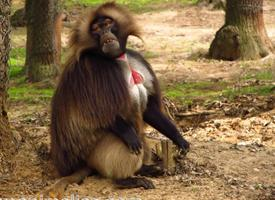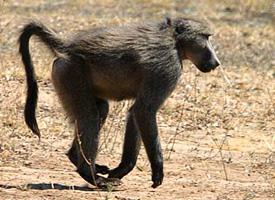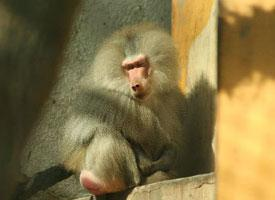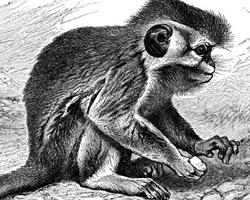
Váhy a míry
| Délka | od 35 do 55 cm |
|---|---|
| Hmotnost | od 0,8 do 1,9 kg |
| Délka ocasu | od 30 do 45 cm |
Biologická data
| Délka březosti | od 155 do 165 d |
|---|---|
| Počet mláďat | 1 |
Stav ohrožení
| Neohrožen |
Popis zvířete
The Angolan talapoin (Miopithecus talapoin), also known as the southern talapoin, is a captivating primate species native to the tropical rainforests and mangrove forests of Central Africa, particularly found in regions spanning from Angola to the Democratic Republic of Congo. This species, along with its northern counterpart, the Gabon talapoin (Miopithecus ogouensis), comprises the genus Miopithecus, which holds the distinction of being among the smallest monkeys in the Old World.Characterized by its diminutive size, the Angolan talapoin typically weighs between 0.8 to 1.3 kilograms, with males generally being slightly larger than females. The body length ranges from 32 to 45 centimeters, not including the tail, which can be just as long if not longer, adding balance and agility as they navigate through the dense foliage of their habitat. Their fur is a soft, olive green on the back, which helps in camouflaging them amongst the trees, while the underparts are lighter, often a pale yellow or gray. One of their most distinctive features is their face: a mask of white fur frames it, highlighting expressive, large eyes that are surrounded by dark patches.
The diet of the Angolan talapoin is omnivorous, consisting mainly of fruits, seeds, aquatic plants, and small invertebrates. This diet reflects their adaptability to the various resources available in their environment. They are particularly adept at foraging near water sources and are known to be excellent swimmers, a trait not commonly observed in many primate species.
Socially, Angolan talapoins are gregarious animals, forming troops that can number from a few individuals to over a hundred, depending on the abundance of food and habitat conditions. These troops are hierarchical, with a complex structure that includes a dominant male, several females to whom he has exclusive breeding rights, and their offspring. Communication within the troop is vital and is facilitated through a variety of vocalizations, body postures, and facial expressions, which serve to coordinate activities, establish social bonds, and alert to potential threats.
Reproduction in the Angolan talapoin involves a gestation period of approximately 160 days, after which a single infant is usually born. The young are incredibly dependent on their mothers for the first few months, clinging to their bellies as the mothers move through the trees. The infants are weaned at about 3 months of age but will often remain close to their mothers until they are fully independent.
Conservation status of the Angolan talapoin is currently listed as Least Concern by the International Union for Conservation of Nature (IUCN), primarily due to its wide distribution and presumed large population. However, like many primate species, they face threats from habitat destruction due to logging, agriculture, and human settlement expansion. Additionally, they are hunted for food in some areas, and their habitats are increasingly fragmented, which could lead to isolated populations and a decrease in genetic diversity.
In summary, the Angolan talapoin is a fascinating and resilient primate, showcasing a remarkable adaptation to its environment. Its social structure, dietary habits, and physical characteristics provide a glimpse into the complexity and diversity of life in the African rainforests. Despite its current conservation status, continuous efforts are needed to ensure that this species, along with its habitat, is preserved for future generations to study, admire, and learn from.
Mapa výskytu
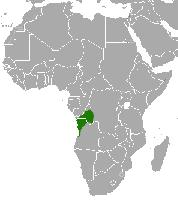
Podobná zvířata
Nové fotografie zvířat
Top 10 zvířat
- Dolphin gull (Leucophaeus scoresbii)
- Diana monkey (Cercopithecus diana)
- Moustached guenon (Cercopithecus cephus)
- Galápagos tortoise (Geochelone nigra complex)
- Japanese macaque (Macaca fuscata)
- Russian tortoise (Testudo horsfieldii)
- Stone loach (Barbatula barbatula)
- Greek tortoise (Testudo graeca)
- Common flying dragon (Draco volans)
- Vendace (Coregonus albula)
